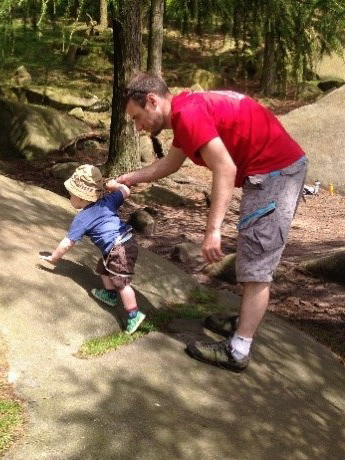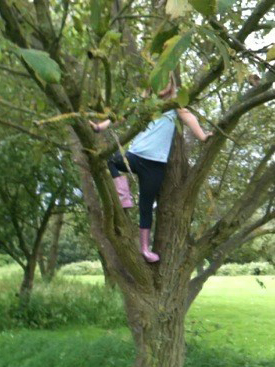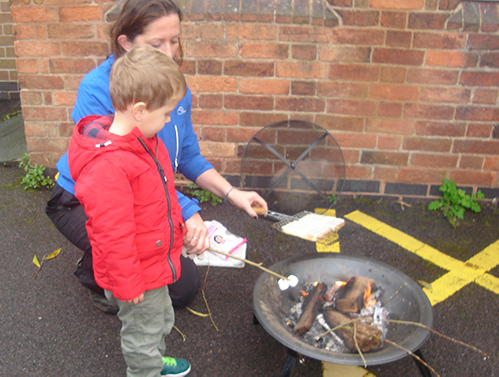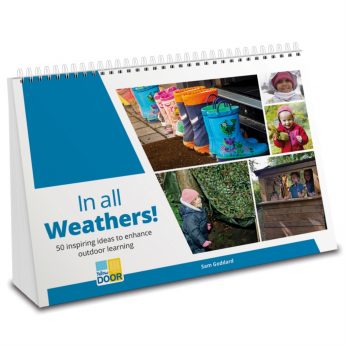6 easy steps to an enabling (not disabling) outdoor risk assessment
When we accompany children outdoors to learn, it can take them outside of their comfort zone; and it can do the same to us as practitioners. Many working in Early Years settings are worried about real and perceived risks that are present when children are active outdoors, and this can be one of the main barriers to settings developing an integrated approach to outdoor learning.

Some of the best outdoor activities come with an element of risk. There is a good reason for this – unless children are given opportunities to explore risk in a supported way during their early years, they may find it more difficult to assess risk and keep themselves safe as they grow up. Risk assessment is a life skill that we use every day, from walking down a busy street to climbing some stairs. We need to give children the opportunities to explore risk and participate in activities that involve an element of age and/or developmentally-appropriate risk.
Supported risk taking has other benefits for children. Take the example of a child climbing a tree. During this activity, they are engaging their gross motor skills and developing muscle use. They are becoming more spatially aware and learning about the properties of the world around them. Social skills will develop as the child communicates with others, talking about how they are climbing. A child who is a proficient climber could help their less confident peers, enhancing their emotional literacy and giving them a sense of responsibility and purpose. None of these benefits would be available if we simply said climbing a tree is too dangerous!

The process of risk assessment helps to make us aware of the potential hazards an activity presents and gives us the means to reduce any risk to a level we are comfortable with. To emphasise, the risk needs to be reduced to a level where it is appropriate rather than removed altogether. As the Health and Safety executive states – environments for children need to be made as safe as necessary, not as safe as possible (www.hse.gov.uk/services/education/sensible-leadership/index.htm).

Here are the 6 simple steps of our risk/benefit process that we find helpful in our own planning – we hope it will prove useful to you too.
- Decide on the activity and think about all the amazing benefits the children will gain from it. This is the fun part! Use your knowledge of the children as well as the EYFS for this.
- Identify any potential hazards. A hazard is anything that might cause harm, which could range from a branch on the ground to a piece of string used in the planned activity. This is best done outdoors, preferably at the site you are going to use for the activity, so you can get a feel for any potential hazards.
- Consider who might be harmed by any hazards, and how. For example, a piece of string could harm a child or adult by getting tangled around their neck or fingers causing a burn, or through ingestion. Be realistic, there is no need to invent risks!
- Decide what you are going to do about this hazard. We call this a control. Is it a high enough risk to remove it altogether or could you highlight it with some sort of visual marker? Perhaps all you need to do is to make the children aware of how to manage a risk. For example, if a tree branch is hanging over your gathering place, you are probably going to want to avoid that area until it has been dealt with by a qualified tree surgeon. On the other hand, some stinging nettles in the corner of your site will probably be best dealt with by showing the children where they are and warning them not to touch them without wearing gloves. You can involve the children in this process, asking for their thoughts and ideas on what level a risk might pose and how it might be dealt with. You might be surprised at how sensible their suggestions are!
- Decide who is going to carry out any control, and when. Put a name against the task, making any action specific and agree a timescale for the work, making a record when it has been resolved.
- Having carried out your control actions, review the consequent level of risk. Balance this against the benefits you noted at the start. The idea is that the benefits now outweigh any potential risks. If they do not, go back and revisit your control methods.

Taken together, the above steps should enable you to carry out a broad and rich array of outdoor learning activities. We are responsible for the opportunities the children in our care have and we must ensure that, while being safe, these opportunities are rich, varied and challenging in order to enable children to flourish in our wonderful outdoor environments!
With thanks to Sam Goddard for writing this blog. Sam founded the Rooted Forest School in 2009, and has over 15 years’ experience working with young children. As a Forest School Practitioner, he still loves getting outdoors with the children and is passionate about the benefits Outdoor Learning and Forest School can bring to all children and adults. Sam is the author of ‘In All Weathers!’ which contains 50 inspiring ideas to enhance outdoor learning in the EYFS.
You may also like:

 Register/Log in
Register/Log in
 Basket
Basket


